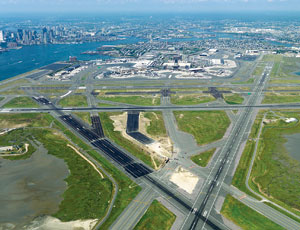The Massachusetts Port Authority is wrapping up a repaving job that features the first application of warm-mix asphalt (WMA) on a U.S. runway. Currently, Federal Aviation Administration specifications do not address warm-mix asphalt. However, the mix is gaining attention because of its environmentally friendly properties.

J.F. White Contracting Co., Boston, began its approximately $12-million contract in July to repave a 7,000-ft-long, 150-ft-wide runway at Boston’s Logan International Airport, says project manager Tom Pyle. The mix was heated to between 250°F and 275°F, as much as 75° degrees less than traditional hot-mix asphalt. Massport officials say warm mix produced nearly 4,000 fewer tons of carbon-dioxide emissions, about 400,000 fewer gallons of diesel fuel and an energy savings of about 53 billion BTUs. The contractor is finishing a month early, with grooving and line striping.
Sam Sleiman, Massport’s director of capital programs and environmental affairs, says the airport first began experimenting with WMA in 2005. “We did a couple of small applications on aprons,” he says. “In 2007, we worked with the FAA to do a test strip on a taxiway.” The results encouraged Massport to use the mix for the runway, and earlier this year FAA approved the idea.
The contractor’s first-time experience was positive. “We had these 82-hour shutdowns” on weekends for repaving, says Pyle. “We were getting these done in half the time.”
Crews were able to place WMA at cooler temperatures and in lifts of up to 6 in. thick, as opposed to 3-in. lifts for hot-mix applications, he notes. “We would definitely work with it again,” Pyle says.
The warm mix included a waxy additive that reduced viscosity. “The FAA has a spec for dense, graded bituminous concrete, similar to highway mixes,” says Craig Bailey, senior civil engineer for FAA’s New England region. “The only difference here is that Massport modified it with [the additive].”
But application differences were tangible. “With this material, if you’re more than 10 ft away, you don’t smell it at all,” Bailey says. “Also, the pavement cools off fairly quickly with a standard mix, so you have limited time to roll and compact. This stays warmer longer.”
Bailey cautions to be careful in maintaining joint temperatures and says handwork is a bit more difficult. “It’s a stiffer material to rake,” he says. But lower application temperatures increase chances the pavement will last longer, he adds.
Sleiman estimates that a total of 56,000 tons of WMA were placed. Although European airports have been using WMA for years, only Logan has done it in the U.S. Previous test applications didn’t require FAA approval for specifications because federal funds were not used. Because the runway repaving was funded through a federal stimulus grant, Massport sought FAA’s approval.
“If I had my way, all our future runway paving would use WMA,” Sleiman says. “Unless something comes up in the next year or so that shows us a problem, we’ll keep asking FAA to allow us to use it. The next step is to convince them that we can place it in thicker lifts.”
Bailey doesn’t think WMA mix approvals will be a problem now that FAA is more familiar with it. As for the chance that other airports may try WMA, he says, “I would expect so.”



Post a comment to this article
Report Abusive Comment